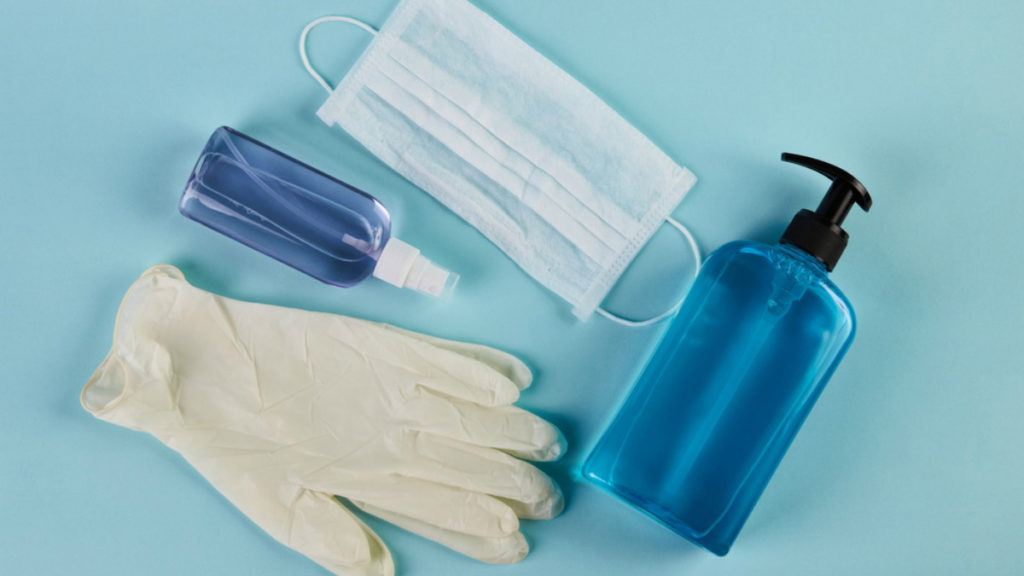Last Updated on January 16, 2021 by Kristin

Taking a road trip during the COVID-19 pandemic? Many Americans are concerned about protecting themselves and others. Here’s your COVID-19 road trip packing list.
COVID-19 Road Trip Essentials
In addition to the usual road trip essentials like snacks, sunscreen and a great playlist, you should be prepared with items that will make you and others safer during the pandemic.
Ask AutoSlash for a Quote on a Cheap Car Rental
The Centers for Disease Control and Prevention (CDC) just released long-awaited guidelines for traveling during the pandemic, which you should read before you go.
Personal Protective Equipment for Road Trips
Whenever you grab your wallet and keys, you have likely gotten into the habit of grabbing protective equipment (PPE) when you leave home. The same applies a road trip. Here’s what to bring:
- Face Coverings: In the vast majority of states and municipalities around the country, you are required to wear a face covering to enter indoor spaces like restaurants, grocery stores and highway rest areas. The CDC encourages all people to wear a cloth mask in public, whether or not they show any symptoms of the virus. Make sure it fits securely over your nose and mouth. Because cloth masks should ideally be cleaned after every use, consider bringing enough disposable masks for the duration of your trip.
- Hand Sanitizer: The CDC recommends washing hands frequently for at least 20 seconds with soap and water, especially after coughing, sneezing or being in a public place. But on a road trip, having access to soap and water after touching surfaces in public areas may not always be possible. Bring along hand sanitizer consisting of at least 60% alcohol to disinfect your hands after any stops.
- Disposable Gloves: Depending on how long you will be away and where you are traveling, it may be a good idea to bring some disposable gloves to wear for certain tasks, like pre-cleaning your rental vehicle or giving a once-over cleaning to a rented vacation home. If you choose to also wear gloves when stopping at a store or gas station, just be sure to dispose of them after each use to avoid cross-contamination.
Cleaners and Sanitizers for Road Trips
The CDC recommends cleaning high-touch surfaces frequently due to the virus being able to live in surfaces for hours or days. On a road trip, this means occasionally wiping down the high-touch areas of your rental vehicle, especially if you will be making numerous stops.
- Alcohol-based Disinfectant Wipes: Disinfecting high-touch car surfaces—door handles, seat belt buckles, steering wheel, control panels, and so on—reduces the risk of inadvertently spreading the virus.
Food, Drinks, Gas and Toiletries
You will want to try to cut down on the number of stops you make, so do a grocery run and stock up on ample snacks, drinks, toiletries and gas before your trip. While stopping to use the bathroom or gas up will be inevitable on very long trips, the goal here is to stop as little as possible to avoid contact with others and touching surfaces in public places. Wear your face mask when you enter any building and wash your hands or use hand sanitizer after each stop.
- Snacks and Drinks: Bring snacks and drinks that are easy to eat in the car. Along the way, choose restaurants that offer drive-through service or takeout. If you want to sit down at a restaurant, choose one with outdoor seating that is following CDC guidelines.
- Toiletries and Medicine: Pick up any necessary toiletries or medicines when you do your pre-trip grocery run to cut down on the number of times you need to go to the store.
- Gas: Fill the tank before heading out to cut down on gas station trips along the way.
Tips for Road Trips During the COVID-19 Pandemic
The CDC offers lots of smart tips on ways to reduce risk of contracting or spreading COVID-19.
Practice social distancing.
As much as possible, avoid areas where you may be within six feet of other people, like hotel lobbies, restaurant entryways, and so on.
Use contactless payments.
Whenever possible, use contactless payment systems (Apple Pay, Google Pay, Samsung Pay, Venmo, Paypal, etc.) instead of handing your credit card to a store or restaurant employee. When paying with cash or credit cards, place them in a receipt tray or on the counter rather in someone else’s hand, if possible. If you are staying overnight at a hotel, see if the property offers touch-less options for online check-in, mobile room key, contactless room service and contactless payment.
Get a QR code reader.
Lots of restaurants are no longer handing out paper menus. Instead, your server may hold up a card featuring a QR code that you can view through your smartphone’s camera. These days, iPhones and most Android phones have a QR code reader built in, and there are also many apps available. Just point your viewfinder at the digital square and the menu will appear on your phone like magic. This is just another way tech is creating fewer items to touch along the travel journey.
Let AutoSlash Track Your Car Rental for Price Drops
Avoid door handles.
Try to avoid touching as many surfaces as possible. If you’re entering or exiting a building with a traditional door and an automatic or revolving door, choose the latter so you don’t have to touch any surfaces. By the same token, use no-touch trash cans.
Avoid elevators.
If possible, the CDC recommends that you take the stairs instead of the elevator. If the elevator is the only viable option, wait until you can either ride alone or only with people from your household. Always wear a face mask inside the elevator.
Choose restaurants carefully.
Steer clear of buffets and self-serve food and drink options to limit the use of shared serving utensils, handles, buttons, or touchscreens. Sit outside if possible and make sure tables are at least six feet apart.
Stick to self-parking options.
Avoid establishments that require you to use a valet service. The idea is to have as little direct contact as possible with both staff members and other diners.
Related:



